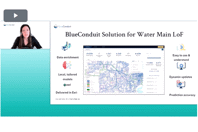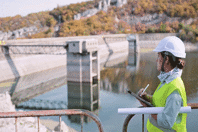
ABOUT BLUECONDUIT
BlueConduit pioneered the predictive modeling approach to lead service line identification and replacement. Through our SaaS platform, utilities, municipalities, government agencies, and consultants standardize, predict, report, and communicate key information about lead.
VIDEOS
-
Ready for a smarter way to assess water main likelihood of failure and risk? Learn more about how BlueConduit's Water Main Predictions tool improves your understanding of water system risk, enables proactive system management, and helps you save time, money, and build community trust.
-
Learn how the Detroit Water & Sewerage Department had its eyes opened to data points that allowed them to be more cost-effective, faster, and more efficient in replacing lead service lines.
-
Make your inventory and replacement plan more accurate using BlueConduit’s statistical modeling and machine learning platform.
-
BlueConduit's data-driven approach helps water systems accurately budget their replacement programs, as well as target their excavations at homes with highest probability of lead.
CONTACT INFORMATION
BlueConduit
2531 Jackson Ave, #337
Ann Arbor, MI 48103
UNITED STATES
Phone: (734) 519-0675
FEATURED ARTICLES
-
Explore why predictive analytics is the new standard for water main risk management.
-
Mandatory LSL replacement is a fundamental shift from the LCR in its approach to service line replacement, moving from a trigger-based approach to a mandatory, system-wide replacement mandate.
-
By waiting for water mains to break before taking action, utilities risk high, unanticipated costs, public disruption, safety concerns, and loss of community trust. So, what does it look like to move from reactive to proactive when it comes to water main management?
-
This blog aims to provide utility managers, policymakers, and the public with a detailed understanding of the current state of water main infrastructure and the environmental challenges faced in maintaining these systems.
-
Using predictive modeling as it relates to identifying the likelihood of lead service lines can feel like a daunting task. Does your water system have to have known lead for predictive modeling to be effective?
-
BlueConduit has a team of national and state policy experts leading our ongoing regulator engagement, internal compliance processes, and technology design to ensure EPA and state-compliant service line inventories.
-
Each state’s guidance on the use of statistical analysis (and predictive modeling) varies. Explore the specifics about your state’s guidance to use statistical analysis for no-lead validation and material classification.
-
What can utilities do to convince customers to check the materials on their side of the line? What is the EPA’s expectation or requirement in this regard?
-
Many water systems are still tackling the challenge of identifying and compliantly managing galvanized and galvanized-requiring-replacement (GRR) service lines.
-
AI-enabled predictive modeling positively impacts four categories: risk mitigation, enhanced decision-making, cost savings, and customer satisfaction.
-
As a water system manager, you know your water system better than anyone. But limited data reduces your ability to make the best decisions on behalf of your customers. That’s where predictive modeling comes in.
-
BlueConduit is proud to support North Carolina water systems as they navigate the NCDEQ’s robust statistical methods and predictive modeling guidance to ensure, with the highest possible confidence, compliance with NCDEQ’s guidance and the most efficient identification and removal of lead service lines for all North Carolina communities.
-
Did you know that the primary value of statistical methods & predictive modeling comes after the initial inventory is created? This is especially true if you believe you have no lead in your system (or have minimal lead) but don’t have records to verify every service line’s material.
-
BlueConduit recently submitted comments to the EPA on the proposed Lead and Copper Rule Improvements (LCRI). We are committed to achieving a lead-free drinking water system through evidence-based decision making and applaud the EPA for establishing a timeline for the replacement of all lead service lines in the United States.
-
Detroit, like many other cities across the U.S., has grappled with a silent threat lurking within its aging water infrastructure: lead service lines. Learn why The Detroit Water and Sewage Department partnered with BlueConduit to help make the lead service line inventory and removal process more efficient than ever before.
-
We talk a lot about ‘compliance’ but the reality is that compliance is complicated and changes over time. This series breaks down compliance requirements across the LCR and the proposed LCRI to help you understand the who, what, and when of compliance.
-
It's time for water systems to start preparing for compliance. Here are some highlights of the proposed changes and how they affect water utilities.
-
Read how machine learning and artificial intelligence allow us to get much more out of the data we collect, finding subtle patterns, capturing complex nuances, and using these to build predictive models.
-
It’s easy to find evidence for a risk of lead exposure from water service lines. How do we show that there isn’t a meaningful risk of lead in our water system?
-
Properly deployed, predictive machine learning can bridge gaps, accelerating the work of modernizing our water systems in an explainable manner that makes the best use of our scarce resources.

























